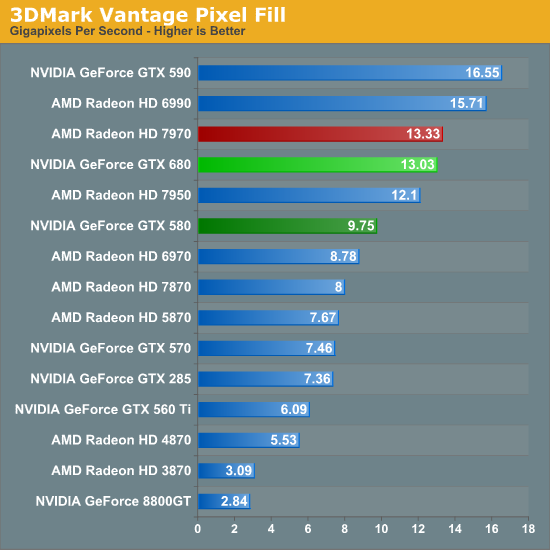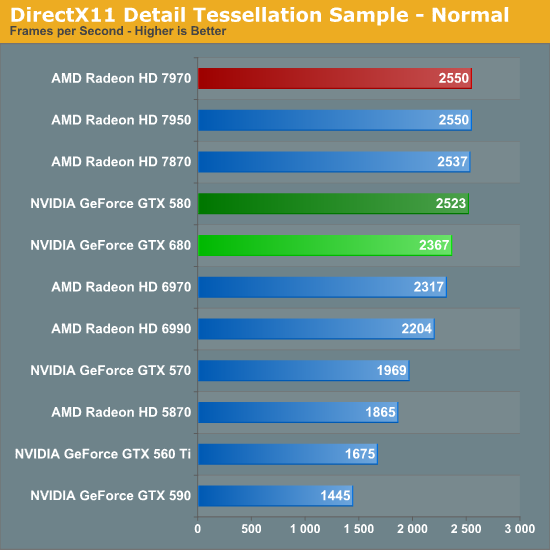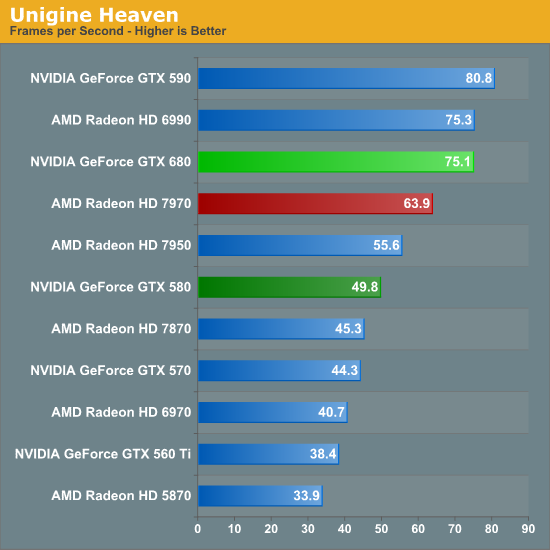NVIDIA GeForce GTX 680 Review: Retaking The Performance Crown
by Ryan Smith on March 22, 2012 9:00 AM ESTTheoreticals
As with any new architecture, we want to take a few moments to look at theoretical performance. These numbers shouldn’t be taken too seriously for cross-vendor comparison, but these numbers often tell us more about interesting architectural improvements that occur from one generation to the next.

Our first theoretical test is perhaps the most perplexing: 3DMark Vantage’s pixel fill test. Typically this test is memory bandwidth bound as the nature of the test has the ROPs pushing as many pixels as possible with as little overhead as possible, which in turn shifts the bottleneck to a mix of ROP performance and the memory bandwidth needed to feed those ROPs.
Compared to the GTX 580, the GTX 680 has almost exactly the same amount of memory bandwidth (192GB/sec) and only 86% of the theoretical ROP performance (37Gpix vs. 32Gpix). In short, it shouldn’t outperform the GTX 580 here, and yet it outperforms the 580 by 33%.
Why does it do this? That’s the hard thing to answer. As we mentioned in our look at GK104’s architecture, NVIDIA did make some minor incremental improvements to their ROPs coming from GF114, such as slightly improved compression and improved polygon merging. One of those may very well be the contributing factor, particularly the compression improvements since this is a typically memory bandwidth bottlenecked test. Alternatively, it’s interesting to note that the difference between the two video cards is almost identical to the difference in the core clock. GTX 560 Ti’s results tend to blow a hole in this theory, but it bears consideration.
In any case, it’s an interesting turn of events and hopefully one that isn’t simply an edge case. As we’ve seen in our benchmarks GTX 680 has strong performance – even if its lead compared to the 7970 diminishes with resolution – but compared to the GTX 580 in particular it needs strong ROP performance across all games in order to deliver good performance at high resolutions and anti-aliasing.

Our second theoretical test is 3DMark Vantage’s texture fill test, which to no surprise has the GTX 680 handily clobbering all prior NVIDIA cards. NVIDIA’s inclusion of 128 texture units on GK104 versus 64 on their previous generation GPUs gives the GTX 680 far better texturing performance. The 30%+ core clock difference only serves to further widen the gap.


Our third theoretical test is the set of settings we use with Microsoft’s Detail Tessellation sample program out of the DX11 SDK. Overall while NVIDIA didn’t make any significant changes to their tessellation hardware (peak triangle rate is still 4/cycle), they have been working on further improving performance at absurdly high tessellation factors. You can see some of this in action at the max factor setting, but even then we’re running into a general performance wall since the Detail Tessellation program can’t go to the absolute highest tessellation factors NVIDIA’s hardware supports.

Our final theoretical test is Unigine Heaven 2.5, a benchmark that straddles the line between a synthetic benchmark and a real-world benchmark as the engine is licensed but no notable DX11 games have been produced using it yet. In any case the Heaven benchmark is notable for its heavy use of tessellation, which means it’s largely a proxy test for tessellation performance. Here we can see the GTX 680 shoot well ahead of the GTX 580 – by more than we saw in the DX11 Detail Tessellation sample – but at the same time there’s a lot more going on in Heaven than just tessellation.
Honestly at this point in time I’m not sure just how much more tessellation performance is going to matter. Until DX11 is the baseline API for games, tessellation is still an add-on feature, which means it’s being used to add fine detail to specific models rather than being used on everything in a game world. This demands good tessellation at high factors but at the same time it’s subject to diminishing returns on the improvement to image quality as triangles reach single pixel sizes and smaller. To that end I’m still waiting to see the day where we see tessellation scale similarly to textures – that is by using full MIP chaining of displacement maps – at which point we can evaluate tessellation performance similar to texture performance when it comes to both measuring the performance hit and evaluating the difference in image quality.










404 Comments
View All Comments
blppt - Thursday, March 22, 2012 - link
Wondering if you guys could also add a benchmark for one the current crop of 1ghz core 7970s that are available now (if you've tested any). Otherwise, great review.tipoo - Thursday, March 22, 2012 - link
With everything being said by Nvidia, I thought this would be a Geforce 8k series class jump, while its really nothing close to that and trades blows with AMDs 3 month old card. GCN definitely had headroom so I can see lower priced, higher clocked AMD cards coming out soon to combat this. Still, I'm glad this will bring things down to sane prices.MarkusN - Thursday, March 22, 2012 - link
Well to be honest, this wasn't supposed to be Nvidias successor to the GTX 580 anyway. This graphics card replaced the GTX 560 Ti, not the GTX 580. GK 110 will replace the GTX 580, even if you can argue that the GTX 680 is now their high-end card, it's just a replacement for the GTX 560 Ti so I can just dream about the performance of the GTX 780 or whatever they're going to call it. ;)tipoo - Thursday, March 22, 2012 - link
I didn't know that, thanks. Ugh, even more confusing naming schemes.Articuno - Thursday, March 22, 2012 - link
If this is supposed to replace the 560 Ti then why does it cost $500 and why was it released before the low-end parts instead of before the high-end parts?MarkusN - Thursday, March 22, 2012 - link
It costs that much because Nvidia realized that it outperforms/trades blows with the HD 7970 and saw an opportunity to make some extra cash, which basically sucks for us consumers. There are those that say that the GTX 680 is cheaper and better than the HD 7970 and think it costs just the right amount, but as usual it's us, the customers, that are getting the shaft again. This card should've been around $300-350 in my opinion, no matter if it beats the HD 7970.coldpower27 - Thursday, March 22, 2012 - link
Nah, they aren't obligated to give more then what the market will bear, no sense in starting a price war when they can have much fatter margins, it beats the 7970 already it's just enough.Now the ball is in AMD's court let's see if they can drop prices to compete $450 would be a nice start, but $400 is necessary to actually cause significant competition.
CeriseCogburn - Friday, March 23, 2012 - link
This whole thing is so nutso but everyone is saying it.Let's take a thoughtful sane view...
The GTX580 flagship was just $500, and a week or two ago it was $469 or so.
In what world, in what release, in the past let's say ten years even, has either card company released their new product with $170 or $200 off their standard flagship price when it was standing near $500 right before the release ?
The answer is it has never, ever happened, not even close, not once.
With the GTX580 at $450, there's no way a card 40% faster is going to be dropped in at $300, no matter what rumor Charlie Demejerin at Semi0-Accurate has made up from thin air up as an attack on Nvidia, a very smart one for not too bright people it seems.
Please, feel free to tell me what flagship has ever dropped in cutting nearly $200 off the current flagship price ?
Any of you ?!?
Lepton87 - Thursday, March 22, 2012 - link
Because nVidia decided to screw its costumer and nickle and dime them. That's why. All because 7970 underperformed and nv could get away with it.JarredWalton - Thursday, March 22, 2012 - link
Or: Because NVIDIA and AMD and Intel are all businesses, and when you launch a hot new product and lots of people are excited to get one, you sell at a price premium for as long as you can. Then supply equals demand and then exceeds demand and that's when you start dropping prices. 7970 didn't underperform; people just expected/wanted more. Realistically, we're getting to the point where doubling performance with a process shrink isn't going to happen, and even 50% improvements are rare. 7970 and 680 are a reflection of that fact.